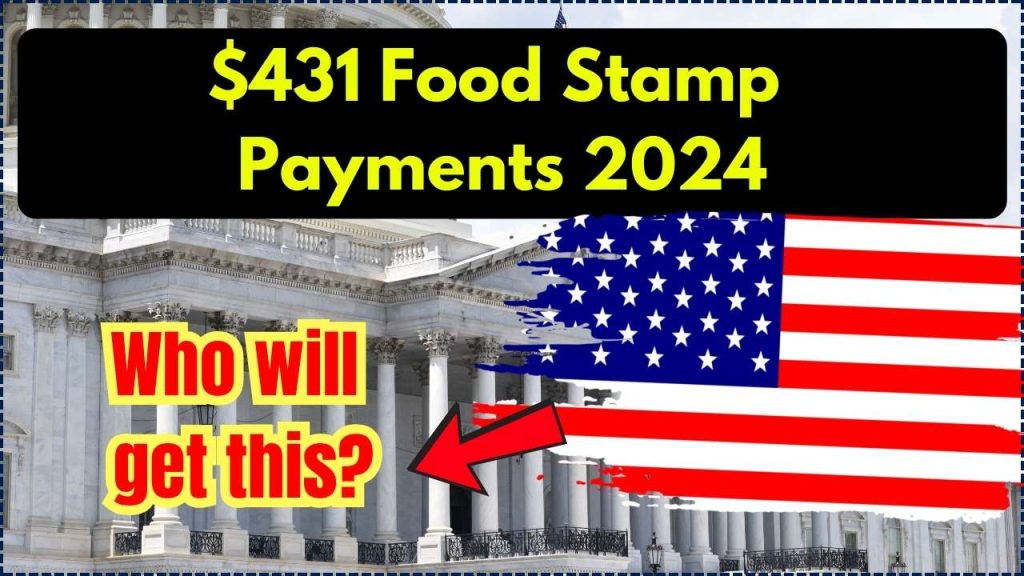
$431 Food Stamp Payments 2024: The Supplemental Nutrition Assistance Program (SNAP), commonly known as “food stamps,” plays a vital role in providing food assistance to millions of Americans, ensuring that families facing financial difficulties have access to nutritious food. In 2024, qualifying households can receive monthly food stamp payments of up to $431 or more, based on their circumstances and location. With recent cost-of-living adjustments (COLA), more people have become eligible, and the monthly payments have increased slightly to address inflation.
In this article, we will explore who qualifies for the $431 SNAP benefit in 2024, the eligibility requirements, how payments are calculated, the dates on which recipients can expect their funds, and additional resources for those in need of food assistance. This comprehensive guide aims to assist both prospective applicants and those looking to understand SNAP better.
$431 Food Stamp Payments 2024
| Detail | Information |
|---|---|
| Maximum Monthly Benefit | $431 for a one-person household in certain regions, such as Guam (higher for larger households or special regions) |
| Eligibility Requirements | Income, household size, and asset limits; typically around 130% of the federal poverty line |
| Application Process | Online application or through local SNAP offices |
| Distribution Schedule | Varies by state; check with local SNAP office or USDA FNS website for specific dates |
| Sources | Center on Budget and Policy Priorities and USDA |
SNAP is an essential support system for millions of Americans, providing food security and nutritional stability. With monthly benefit caps like the $431 available to single-person households in Guam and increased income thresholds, the program aims to make food accessible for low-income individuals and families. Understanding eligibility criteria, the application process, and monthly distribution schedules help households make the most of this vital program. For more information, refer to the [Center on Budget and Policy Priorities](https://www.cbpp.org/research/food-assistance/a-quick-guide-to-snap-eligibility-and-benefits) or consult your local SNAP office.
What is SNAP, and Why is it Important?
The Supplemental Nutrition Assistance Program (SNAP) is a federal aid program designed to help low-income individuals and families afford food. Its primary goal is to reduce hunger and improve nutrition among those who might otherwise struggle to purchase enough food for a balanced diet. Benefits are typically distributed monthly through an Electronic Benefits Transfer (EBT) card, accepted at most grocery stores and supermarkets.
The significance of SNAP extends beyond just providing food; it helps to improve health, stabilize households, and support local economies. In times of economic uncertainty, such as the recent inflationary period, SNAP provides critical assistance to those hardest hit by rising costs.
How Does SNAP Determine Eligibility?
Core Eligibility Factors
SNAP eligibility is determined primarily by household size, income, assets, and certain allowable deductions. Guidelines are set by the USDA and applied at the state level, meaning requirements may vary slightly based on location. Here are the core eligibility factors:
- Income Limits: Typically, gross monthly income must be at or below 130% of the federal poverty line. For example:
- For a single-person household, the monthly limit is about $1,473.
- For a family of three, the limit is around $2,798.
- Net Monthly Income Limits: After deductions, income should be at or below 100% of the federal poverty line. This includes deductions for rent, utilities, child care, and other essential expenses.
- Asset Limits: Households without elderly or disabled members must have assets of $3,000 or less, while those with qualifying members can have up to $4,500 in assets.
In high-cost-of-living areas like Alaska, Hawaii, Guam, and the U.S. Virgin Islands, income thresholds and benefit amounts are higher. For instance, the maximum benefit for a single-person household in Guam is $431, a reflection of the elevated cost of living there.
Deductions That Impact Eligibility
Households can subtract specific standard deductions for basic living costs, including utility bills, housing, and child care expenses, which helps increase net income eligibility. Additionally, households with elderly or disabled members often qualify for higher deductions, expanding their access to SNAP benefits.
How Benefits Are Calculated
Each household’s SNAP benefit is calculated based on monthly income, allowable deductions, and family size. The basic formula for calculating benefits is as follows:
- Determine Household Size: Larger households qualify for higher benefits.
- Calculate Gross and Net Monthly Income: Gross income includes all income sources, while net income accounts for allowable deductions.
- Multiply Net Income by 30%: This amount is expected to be covered by the household, and the remaining amount is provided by SNAP up to the household’s benefit cap.
Example Calculation:
Example: A family of three with a net monthly income of $600
- Household Size: 3
- Maximum Monthly Benefit: $768
- Expected Contribution: $600 x 30% = $180
- Monthly SNAP Benefit: $768 – $180 = $588
This calculation reflects how SNAP benefits are tailored based on both household income and family size.
How and When to Apply for SNAP Benefits
Applying for SNAP is relatively straightforward and typically involves the following steps:
- Visit Your State’s SNAP Portal: Most states offer an online application option. Alternatively, visit a local SNAP office to apply in person.
- Prepare Required Documents: Gather proof of income, expenses (like utility bills), identity, and any asset documentation.
- Submit Application: Ensure all questions are completed accurately.
- Participate in an Eligibility Interview: This interview, either in person or over the phone, confirms eligibility details.
- Wait for Approval: Applications are typically processed within 30 days, but expedited benefits may be available for those in extreme financial need.
For exact details on state-specific requirements, refer to your state’s SNAP office or visit the USDA Food and Nutrition Service (FNS) website.
Payment Distribution Dates for 2024
SNAP distribution dates vary by state and are based on criteria such as case number or last name. Here are examples:
- California: Payments are issued between the 1st and 10th, based on case number.
- Texas: SNAP benefits are issued between the 1st and 15th, according to the last digit of the case number.
- Pennsylvania: Distribution varies by county and the last digit of the case number.
Check your state’s distribution schedule to find out the specific date for your household.
Additional Resources for Food Assistance
If you or someone you know is struggling with food security, there are additional programs and resources available:
- Women, Infants, and Children (WIC): Offers food assistance to low-income pregnant women, new mothers, and children under five.
- National School Lunch Program (NSLP): Provides low-cost or free lunches to children in schools.
- Local Food Banks: Many communities have food banks that offer free groceries to those in need.
Visit Feeding America or the USDA Food Assistance website for more resources.
$16,800 Expense Payment Aid Only For These Americans In November 2024: Check How to get it
Social Security Payments Halted This Week in November 2024: Check Your Eligibility and Amounts
$8000 SSI Hike For Married SSI Recipients In 2024: Know Eligibility & Application Process
Common Misconceptions About SNAP
- “SNAP is Only for the Unemployed”: Many working families qualify for SNAP. Low-wage workers, particularly in high-cost areas, often rely on SNAP to supplement their food budget.
- “You Can Only Buy Certain Foods”: While SNAP funds can’t be used for hot or prepared foods, they cover a wide variety of groceries, including fresh produce, meats, dairy products, and more.
- “Applying for SNAP is Complicated”: Many states offer streamlined online applications, making it easier for individuals to apply. Additionally, assistance is available for those needing help with the process.
FAQs On $431 Food Stamp Payments 2024
1. How do I know if I’m eligible for SNAP benefits?
Eligibility is determined by income, household size, and certain deductions. You can use the USDA’s SNAP Eligibility Calculator for an estimate.
2. How long does it take to get approved for SNAP?
Approval typically takes around 30 days, though expedited benefits may be available for households with very low incomes.
3. Can I receive SNAP benefits if I have a job?
Yes, many employed individuals qualify for SNAP. The program considers net income after allowable deductions, meaning many working families meet the criteria.
4. When will I receive my SNAP benefits?
Your benefit date depends on your state’s schedule. Check with your local SNAP office or the USDA website for exact distribution dates.
5. What can SNAP benefits be used for?
SNAP benefits can be used to buy most grocery items, including fresh fruits, vegetables, meats, dairy, and bread. However, they cannot be used for alcohol, tobacco, household items, or prepared foods.

